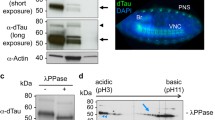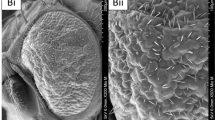Abstract
Background
Tau, Amyloid-beta (Aβ42), and Glycogen synthase kinase 3 (GSK3) contribute to synaptic dysfunction observed in Alzheimer's disease (AD), the most common form of dementia. In the current study, the effect of pan-neuronal expression of TauWT, Aβ42, or shaggy (orthologue of GSK3) in Drosophila melanogaster was assessed on the locomotor function, ethanol sensitivity, synaptic genes and CREB expression. The effect of TauWT and Aβ42 on the expression of shaggy was also determined.
Methods and results
Gene expression analysis was performed using quantitative real-time RT-PCR method. While syt1, SNAP25 and CREB (upstream transcription factor of syt1 and SNAP25) were upregulated in flies expressing TauWT or Aβ42, a prominent decline was observed in those genes in shaggy expressing flies. Although all transgenic flies showed climbing disability and higher sensitivity to ethanol, abnormality in these features was significantly more prominent in transgenic flies expressing shaggy compared to TauWT or Aβ42. Despite a significant upregulation of shaggy transcription in TauWT expressing flies, Aβ42 transgenic flies witnessed no significant changes.
Conclusions
TauWT, Aβ42, and shaggy may affect synaptic plasticity through dysregulation of synaptic genes and CREB, independently. However shaggy has more detrimental effect on synaptic genes expression, locomotor ability and sensitivity to ethanol. It is important when it comes to drug discovery. It appears that CREB is a direct effector of changes in synaptic genes expression as they showed similar pattern of alteration and it is likely to be a part of compensatory mechanisms independent of the GSK3/CREB pathway in TauWT or Aβ42 expressing flies.





Similar content being viewed by others
References
Mota SI, Ferreira IL, Rego AC (2014) Dysfunctional synapse in Alzheimer’s disease—a focus on NMDA receptors. Neuropharmacology 76:16–26. https://doi.org/10.1016/j.neuropharm.2013.08.013
Lauretti E, Dincer O, Practicò D (2020) Glycogen synthase kinase-3 signaling in Alzheimer’s disease. Biochim Biophys Acta BBA 1867:664. https://doi.org/10.1016/j.bbamcr.2020.118664
Selkoe DJ (2002) Alzheimer’s disease is a synaptic failure. Science 298(5594):789–791. https://doi.org/10.1126/science.1074069
Pooler AM, Noble W, Hanger DP (2014) A role for Tau at the synapse in Alzheimer’s disease pathogenesis. Neuropharmacology 76:1–8. https://doi.org/10.1016/j.neuropharm.2013.09.018
Rajmohan R, Reddy PH (2017) Amyloid-beta and phosphorylated tau accumulations cause abnormalities at synapses of Alzheimer’s disease neurons. J Alzheimers Dis 57(4):975–999. https://doi.org/10.3233/JAD-160612
Engel T, Gómez-Sintes R, Alves M et al (2018) Bi-directional genetic modulation of GSK-3β exacerbates hippocampal neuropathology in experimental status epilepticus. Cell Death Dis 9(10):1–14. https://doi.org/10.1038/s41419-018-0963-5
Abtahi SL, Masoudi R, Haddadi M (2020) The distinctive role of Tau and amyloid beta in mitochondrial dysfunction through alteration in Mfn2 and Drp1 mRNA levels: a comparative study in Drosophila melanogaster. Gene 754:144854. https://doi.org/10.1016/j.gene.2020.144854
Matarin M, Salih DA, Yasvoina M et al (2015) A genome-wide gene-expression analysis and database in transgenic mice during development of amyloid or tau pathology. Cell Rep 10(4):633–644. https://doi.org/10.1016/j.celrep.2014.12.041
Sebollela A, Freitas-Correa L, Oliveira FF et al (2012) Amyloid-β oligomers induce differential gene expression in adult human brain slices. J Biol Chem 287(10):7436–7445. https://doi.org/10.1074/jbc.M111.298471
Berchtold NC, Sabbagh MN, Beach TG, Kim RC, Cribbs DH, Cotman CW (2014) Brain gene expression patterns differentiate mild cognitive impairment from normal aged and Alzheimer’s disease. Neurobiol Aging 35(9):1961–1972. https://doi.org/10.1016/j.neurobiolaging.2014.03.031
Bossers K, Wirz KT, Meerhoff GF et al (2010) Concerted changes in transcripts in the prefrontal cortex precede neuropathology in Alzheimer’s disease. Brain 133(12):3699–3723. https://doi.org/10.1093/brain/awq258
Sze CI, Bi H, Kleinschmidt-DeMasters BK, Filley CM, Martin LJ (2000) Selective regional loss of exocytotic presynaptic vesicle proteins in Alzheimer’s disease brains. J Neurol Sci 175(2):81–90. https://doi.org/10.1016/s0022-510x(00)00285-9
Saura CA, Parra-Damas A, Enriquez-Barreto L (2015) Gene expression parallels synaptic excitability and plasticity changes in Alzheimer’s disease. Front Cell Neurosci 9:318. https://doi.org/10.3389/fncel.2015.00318
Shin OH (2014) Exocytosis and synaptic vesicle function. Compr Physiol 4:149–175. https://doi.org/10.1002/cphy.c130021
Mundigl O, Verderio C, Krazewski K, De Camilli P, Matteoli M (1995) A radioimmunoassay to monitor synaptic activity in hippocampal neurons in vitro. Eur J Cell Biol 66(3):246–256
Liu YF, Chen HI, Wu CL et al (2009) Differential effects of treadmill running and wheel running on spatial or aversive learning and memory: roles of amygdalar brain-derived neurotrophic factor and synaptotagmin I. J Physiol 587(13):3221–3231. https://doi.org/10.1113/jphysiol.2009.173088
Noor A, Zahid S (2017) A review of the role of synaptosomal-associated protein 25 (SNAP-25) in neurological disorders. Int J Neurosci 127(9):805–811. https://doi.org/10.1080/00207454.2016.1248240
Barrenschee M, Böttner M, Harde J et al (2015) SNAP-25 is abundantly expressed in enteric neuronal networks and upregulated by the neurotrophic factor GDNF. Histochem Cell Biol 143(6):611–623. https://doi.org/10.1007/s00418-015-1310-x
Kaldun JC, Sprecher SG (2019) Initiated by CREB: Resolving gene regulatory programs in learning and memory: switch in cofactors and transcription regulators between memory consolidation and maintenance network. BioEssays 41(8):1900045. https://doi.org/10.1002/bies.201900045
Bartolotti N, Bennett DA, Lazarov O (2016) Reduced pCREB in Alzheimer’s disease prefrontal cortex is reflected in peripheral blood mononuclear cells. Mol Psychiatry 21(9):1158–1166. https://doi.org/10.1038/mp.2016.111
Pugazhenthi S, Wang M, Pham S, Sze CI, Eckman CB (2011) Downregulation of CREB expression in Alzheimer’s brain and in Aβ-treated rat hippocampal neurons. Mol Neurodegener 6(1):1–16. https://doi.org/10.1186/1750-1326-6-60
Sanabria-Castro A, Alvarado-Echeverría I, Monge-Bonilla C (2017) Molecular pathogenesis of Alzheimer’s disease: an update. Ann Neurosci 24(1):46–54. https://doi.org/10.1159/000464422
Tan FH, Azzam G (2017) Drosophila melanogaster: deciphering Alzheimer’s disease. Malay J Med Sci 24(2):6. https://doi.org/10.21315/mjms2017.24.2.2
Skaper SD (2012) Alzheimer’s disease and amyloid: culprit or coincidence. Int Rev Neurobiol 102:277–316. https://doi.org/10.1016/B978-0-12-386986-9.00011-9
Goedert M, Spillantini MG (2000) Tau mutations in frontotemporal dementia FTDP-17 and their relevance for Alzheimer’s disease. Biochim Biophys Acta 1502(1):110–121. https://doi.org/10.1111/j.1749-6632.2000.tb06907.x
Ali YO, Escala W, Ruan K, Zhai RG (2011) Assaying locomotor, learning, and memory deficits in Drosophila models of neurodegeneration. J Vis Exp 49:e2504
Maples T, Rothenfluh A (2011) A simple way to measure ethanol sensitivity in flies. J Vis Exp 48:e2541. https://doi.org/10.3791/2541
Livak KJ, Schmittgen TD (2001) Analysis of relative gene expression data using real-time quantitative PCR and the 2− ΔΔCT method. Methods 25(4):402–408. https://doi.org/10.1006/meth.2001.1262
Albers MW, Gilmore GC, Kaye J et al (2015) At the interface of sensory and motor dysfunctions and Alzheimer’s disease. Alzheimers Dement 11(1):70–98. https://doi.org/10.1016/j.jalz.2014.04.514
Moloney A, Sattelle DB, Lomas DA, Crowther DC (2010) Alzheimer’s disease: insights from Drosophila melanogaster models. Trends Biochem Sci 35(4):228–235. https://doi.org/10.1016/j.tibs.2009.11.004
Guarnieri DJ, Heberlein U (2003) Drosophila melanogaster, a genetic model system for alcohol research. Int Rev Neurobiol 54:199–228. https://doi.org/10.1016/s0074-7742(03)54006-5
Kapoor M, Chao MJ, Johnson EC et al (2021) Multi-omics integration analysis identifies novel genes for alcoholism with potential overlap with neurodegenerative diseases. Nat Commun 12(1):1–12. https://doi.org/10.1038/s41467-021-25392-y
Ryvkin J, Bentzur A, Zer-Krispil S, Shohat-Ophir G (2018) Mechanisms underlying the risk to develop drug addiction, insights from studies in Drosophila melanogaster. Front Physiol 9:327. https://doi.org/10.3389/fphys.2018.00327
Zhang X, Odom DT, Koo SH et al (2005) Genome-wide analysis of cAMP-response element binding protein occupancy, phosphorylation, and target gene activation in human tissues. Proc Natl Acad Sci USA 102(12):4459–4464. https://doi.org/10.1073/pnas.0501076102
Blalock EM, Geddes JW, Chen KC, Porter NM, Markesbery WR, Landfield PW (2004) Incipient Alzheimer’s disease: microarray correlation analyses reveal major transcriptional and tumor suppressor responses. Proc Natl Acad Sci USA 101(7):2173–2178. https://doi.org/10.1073/pnas.0308512100
Beurel E, Grieco SF, Jope R (2015) Glycogen synthase kinase-3 (GSK3): regulation, actions, and diseases. Pharmacol Ther 148:114–131. https://doi.org/10.1016/j.pharmthera.2014.11.016
Kerr F, Augustin H, Piper MD et al (2011) Dietary restriction delays aging, but not neuronal dysfunction, in Drosophila models of Alzheimer’s disease. Neurobiol Aging 32(11):1977–1989. https://doi.org/10.1016/j.neurobiolaging.2009.10.015
Park A, Ghezzi A, Wijesekera TP, Atkinson NS (2017) Genetics and genomics of alcohol responses in Drosophila. Neuropharmacology 122:22–35. https://doi.org/10.1016/j.neuropharm.2017.01.032
Sofola O, Kerr F, Rogers I et al (2010) Inhibition of GSK-3 ameliorates Aβ pathology in an adult-onset Drosophila model of Alzheimer’s disease. PLoS Genet 6(9):e1001087. https://doi.org/10.1371/journal.pgen.1001087
Bell KF, Bennett DA, Cuello AC (2007) Paradoxical upregulation of glutamatergic presynaptic boutons during mild cognitive impairment. J Neurosci 27(40):10810–10817. https://doi.org/10.1523/JNEUROSCI.3269-07.2007
Hämäläinen A, Pihlajamäki M, Tanila H, Hänninen T, Niskanen E, Tervo S, Karjalainen PA, Vanninen RL, Soininen H (2007) Increased fMRI responses during encoding in mild cognitive impairment. Neurobiol Aging 28(12):1889–1903. https://doi.org/10.1016/j.neurobiolaging.2006.08.008
Dong XX, Wang Y, Qin ZH (2009) Molecular mechanisms of excitotoxicity and their relevance to pathogenesis of neurodegenerative diseases. Acta Pharmacol Sin 30(4):379–387. https://doi.org/10.1038/aps.2009.24
Rosa E, Fahnestock M (2015) CREB expression mediates amyloid β-induced basal BDNF downregulation. Neurobiol Aging 36(8):2406–2413. https://doi.org/10.1016/j.neurobiolaging.2015.04.014
Chiang A, Priya R, Ramaswami M, Vijayraghavan K, Rodrigues V (2009) Neuronal activity and Wnt signaling act through Gsk3-β to regulate axonal integrity in mature Drosophila olfactory sensory neurons. Development 136(8):1273–1282. https://doi.org/10.1242/dev.031377
Cuesto G, Jordán-Álvarez S, Enriquez-Barreto L et al (2015) GSK3β inhibition promotes synaptogenesis in Drosophila and mammalian neurons. PLoS ONE 10(3):e0118475. https://doi.org/10.1371/journal.pone.0118475
Franciscovich AL, Mortimer AV, Freeman AA, Gu J, Sanyal S (2008) Overexpression screen in Drosophila identifies neuronal roles of GSK-3β/shaggy as a regulator of AP-1-dependent developmental plasticity. Genetics 180(4):2057–2071. https://doi.org/10.1534/genetics.107.085555
Acknowledgements
This work was financially supported by a research grant from Shiraz University. The authors would like to thank Amir-Hussein Hadaegh (Central Laboratory of Shiraz University of Medical Sciences) for his assistance and helpful comments.
Author information
Authors and Affiliations
Contributions
RM, conceived the presented idea, designed the experiments, contributed to the interpretation of the results and writing the manuscript. FA, performed the molecular and behavioral experiments and their statistical analysis and interpretation, wrote the manuscript and contributed to the conception of the idea. MH, guided and helped to design the experiments related to flies and provided the Drosophila stocks.
Corresponding author
Ethics declarations
Ethical approval
Drosophila experiments do not require ethics committee approval. However, all expreriments were conducted ethically and the number of animals used as kept to a minimum.
Consent to participate
Not applicable.
Consent to participate
Not applicable.
Competing interests
The authors of this article declare that they have no conflict of interest.
Additional information
Publisher's Note
Springer Nature remains neutral with regard to jurisdictional claims in published maps and institutional affiliations.
Supplementary Information
Below is the link to the electronic supplementary material.
Rights and permissions
Springer Nature or its licensor (e.g. a society or other partner) holds exclusive rights to this article under a publishing agreement with the author(s) or other rightsholder(s); author self-archiving of the accepted manuscript version of this article is solely governed by the terms of such publishing agreement and applicable law.
About this article
Cite this article
Ataellahi, F., Masoudi, R. & Haddadi, M. Differential dysregulation of CREB and synaptic genes in transgenic Drosophila melanogaster expressing shaggy (GSK3), TauWT, or Amyloid-beta. Mol Biol Rep 50, 1101–1108 (2023). https://doi.org/10.1007/s11033-022-08059-9
Received:
Accepted:
Published:
Issue Date:
DOI: https://doi.org/10.1007/s11033-022-08059-9




